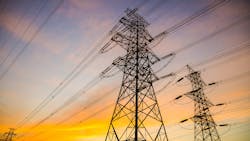As demand for electricity grew, more power plants were located near population centers. The early system had constraints: The voltage of direct current systems could not easily be increased for long-distance transmission; different classes of loads required distinct voltages; and thus, these deficiencies launched the proliferation of distinct generators, distribution systems, and circuits. Ironically, the generation and distribution model of the 19th century power sector resembles modern distributed generation systems, which some predict will eventually become the most commonplace model in the future.
Inefficient transmission resulting from specialized power lines was the status quo until the arrival of alternating current (AC) transmission in 1881, which revolutionized the new sector. This breakthrough was fully recognized when the first long distance AC line – 21 miles long -- was built for the 1884 International Exhibition in Turin, Italy.
From this point forward, the U.S. power grid continued its growth throughout the 20th century. Massive hydroelectric generation, as well as coal and heavy fuel oil, were utilized to meet the increasing demand for electricity. The Federal Power Commission was founded in 1920 – initially to coordinate hydropower development -- and then transformed in 1935 into an independent agency to regulate both hydropower and interstate electricity. Natural gas and nuclear facilities with huge generation capabilities were subsequently brought online.
In 1977, the FPC’s successor, the Federal Energy Regulatory Commission (FERC), was founded with its current mission: to ‘assist consumers in obtaining economically efficient, safe, reliable, and secure energy services at a reasonable cost.’ Regional transmission organizations and independent system operators were created to begin the process of moving power across larger geographic footprints, thereby expanding the capabilities and strengthening connections between utility systems, as well as adding new non-utility generation. These developments allowed for the more diverse, reliable, and efficient exchange of power. The Energy Policy Act of 2005 expanded FERC's authority to impose mandatory reliability standards on the bulk transmission system and to impose penalties for the manipulation of electricity and natural gas markets.
Every year, Black & Veatch issues a Strategic Directions: Electric Report reflecting expert analyses of its annual survey of more than 600 power sector stakeholders and identifying emerging trends, challenges, and opportunities. The 2020 survey revealed that the most challenging issue facing the electricity industry, according to one-third of the respondents, is an aging infrastructure. Although universally cited, it was particularly noted as the top challenge among three in 10 respondents in the Northeast, South and West.
The Texas grid failures in February 2021 underscore the significant nature of the problem. Over President’s Day weekend, 70% of ERCOT’s 26 million customers were without electricity service, as were 5 million people in Mexico. Although the outages had multiple causes – disrupted power supplies, unexpectedly high customer demand, and frozen infrastructure – the consequences were catastrophic. The outcomes will be debated, litigated, and remembered for years to come.
Looking Ahead
Looking further into the 21st century, regional and interregional power demand is expected to increase for many reasons: improved reliability, greater resilience, increased cost-effectiveness, and most notably, higher utilization of energy generated by clean sources. While much of the current transmission infrastructure is aging and in need of updating and/or augmenting, several barriers exist inhibiting its improvement: siting and permitting, environmental concerns, cost apportionment, and overall public acceptance, including visual aesthetic.
There are encouraging emerging signs. DOE Secretary Granholm’s testimony during her confirmation hearing before the Senate Energy Committee noted her eagerness to work with the Federal Energy Regulatory Commission (FERC) to construct transmission lines from midwestern renewable energy sources to demand centers in the eastern United States.
A 2019 paper co-authored by FERC Chairman Richard Glick, FERC and Climate Change, acknowledged the nation’s changing energy resource mix and the emergence of new technologies that have potentially significant implications for the transmission grid. The paper supports a return on equity sufficient to attract new investment for transmission facilities that are necessary to develop the grid of the future.
The Biden Administration’s $2T infrastructure package, although bearing an uncertain legislative future, is seen by some as a potentially useful foundation for overall economic recovery and the stimulation of new clean energy jobs and technologies. The continuing support for renewable energy — as evidenced in the record 2020 wind and solar installations and the Congressional tax credit renewals — will likely spur demand for greater transmission capabilities. The fiasco in Texas has brought several industry debates to the forefront that focus on generation, delivery, and consumption in the broadest infrastructural context. As more public attention is devoted to infrastructure over the coming weeks and months, the opportunity to promote dialogue on a path forward exists.
Sheila Slocum Hollis is acting executive director of the United States Energy Association.
About the Author
Sheila Hollis
Sheila Slocum Hollis is Acting Executive Director of the United States Energy Association. Through its membership, USEA represents 150 members across the U.S. energy sector from the largest Fortune 500 companies to small energy consulting firms. In her role, Ms. Hollis represents the broad interests of the U.S. energy industry and interacts with domestic and international leaders to advance knowledge and seek partnerships to develop and enhance energy infrastructure worldwide.
